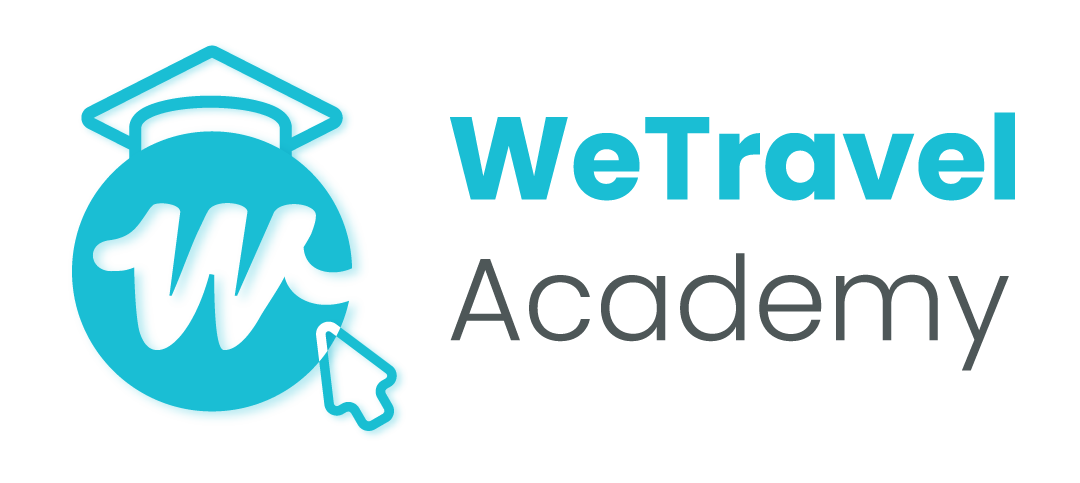How To Grow A Stellar Review Profile To Increase Enquiries And Conversions
Reviews are critical to the success of a travel operator’s business. Almost all travelers today will seek out reviews and social proof before they book their travel.
Tnooz reports that over 95% of leisure travelers read at least 7 reviews before booking their holidays. And according to Bright Local Study, 79% of travelers trust online reviews as much as personal recommendations.
As a travel operator, if you don’t have a well-established, largely positive review profile, then you are undoubtedly leaving money on the table.
This article is for tour operators who already have a basic online review presence, but are looking to scale things up. We provide a road map on how to generate a consistent flow of positive reviews.
By the end of the article you will know:
1. How to consistently grow your review profile.
2. How to expand your review presence across multiple platforms.
3. How to manage bad reviews.
Reading Time: 11 Minutes
Review Road Map
Quickly type into Google: "[Your Company Name] Reviews". What does the result look like?
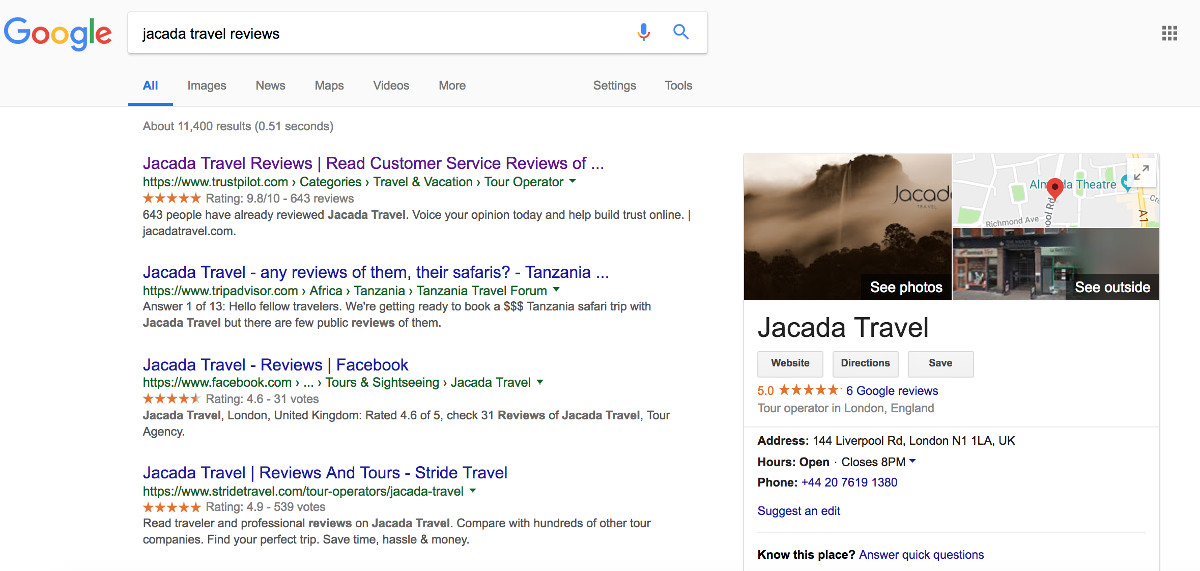
The best travel companies fixate on making this search result look impressive.
For example, have a look at the search result for Jacada Travel above. Notice the 5 star reviews that dominate three of the first four results, and are also prevalent in their Google business listing.
A review profile like this one sends a very strong message to a prospective customer that this company is trust-worthy and has an impressive track record.
It goes without saying that to build a review profile like Jacada Travel you need to have an amazing service, a topic we deal with in our article on Service Delivery, but in addition to that you need to have a clear road map on where you are trying to get to.
The road map should set out the review network you plan to focus on, the system you plan to use to collect reviews, the process by which you broaden your review presence and way you deal with bad reviews.
Let’s look at each in turn.
Choosing a Review Network
The first step to building a big review presence is choosing the right review network to collect customer reviews.
As a small tour operator it is best to host your reviews on an independent and trusted 3rd party platform. Nothing screams unreliable more than a review profile that is built and controlled directly in-house by a company.
We always recommend that you initially focus your review-building efforts on a single platform.
Many newbies try spreading their reviews across multiple platforms, but this often dilutes the impact. Broadening your review presence is only a good idea once you have an established review profile on a quality network.
The most respected review platforms for travel operators include Tripadvisor, Trustpilot, Feefo, Yotpo and the Association of Independent Tour Operators (AITO).
Use the comparison table below to decide which platform is best for you.

Operational Process for Reviews
To consistently get good reviews you need to build a systemized process into your operation for seeking feedback from customers and collecting reviews.
There are three parts to building a good system for collecting reviews.
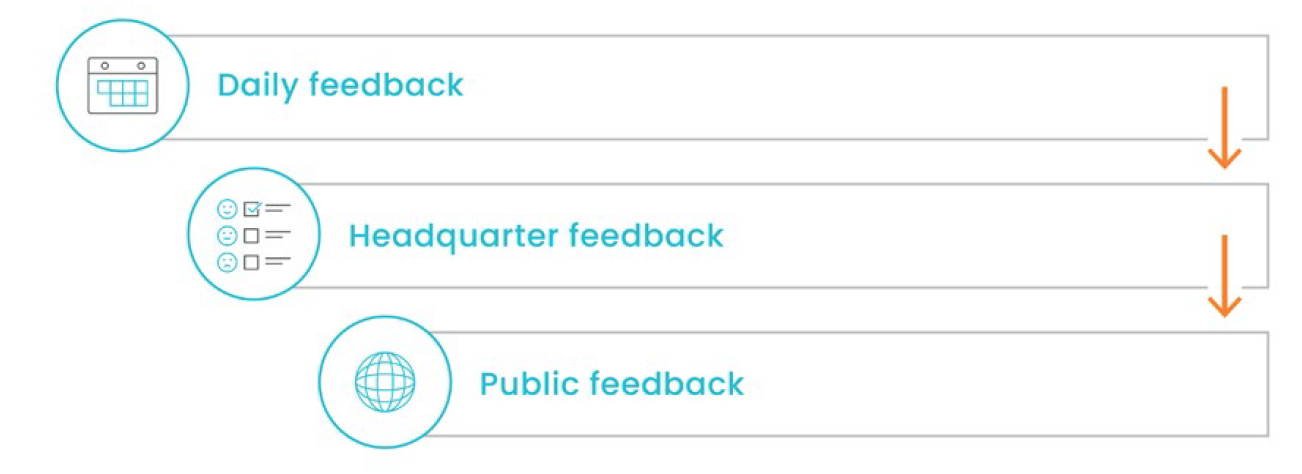 Each part seeks to take a measure of how a customer experienced your service and allows you to take corrective measures before a customer leaves a public review.
Each part seeks to take a measure of how a customer experienced your service and allows you to take corrective measures before a customer leaves a public review.
Daily feedback
One of the main reasons why tour operators get bad reviews is that they don’t seek daily feedback.
The fastest and easiest way to correct issues for a customer is on the day an issue arises.
In addition to providing the best service for a customer, it is a very good practice to assign an customer liaison that touches base on a daily basis to make sure a customer’s expectations are met.
An customer liaison, like a country manager, should ideally be at an arms length from the customer, and not be the lead guide or the person running a tour. Many customers prefer not to give direct feedback to a guide and instead like passing feedback through to a country manager.
This type of customer engagement doesn’t need to be formal or long-winded. It can simply be a quick exchange to ask a customer how their day went, explain what is planned for the next day and find out if there is anything that could be done better.
On the final day of a tour it is always worth asking customers to complete a short questionnaire on their experience. For best results, the customer should be given a sealed envelope for their questionnaire answers and the envelope should be collected by the customer liaison.
All feedback should then be passed to the head office and the customer liaison should make a point to identify any customers who have expressed dissatisfaction.
QUICK EXERCISE
Think about your current daily feedback process. Do you have a customer liaison that seeks feedback from customers on a regular basis? Is this person different from the main tour guide? Do you have a sealed envelope feedback questionnaire?
What processes can you introduce to improve the feedback process?
Headquartre Feedback
It is very easy to forget about customers after a tour is finished, but this is a mistake.
To encourage reviews and drive repeat business, a post-trip follow up is a must. You should start with reviewing the tour questionnaire and debrief from the customer liaison. Any issues should be noted and significant issues should be addressed on a case-by-case basis.
Generally, if your service delivery is strong, the feedback will be great.
At this point we recommend sending customers a short online feedback questionnaire. To encourage customers to leave feedback, you should explain how much you value customer feedback and ask if they could spare a few minutes to answer a few questions.
The online survey should be short, with just 3-4 multiple-choice questions, but should importantly include one question where customers can write in detail about their overall assessment of a tour.
Here is an example of an online feedback survey.
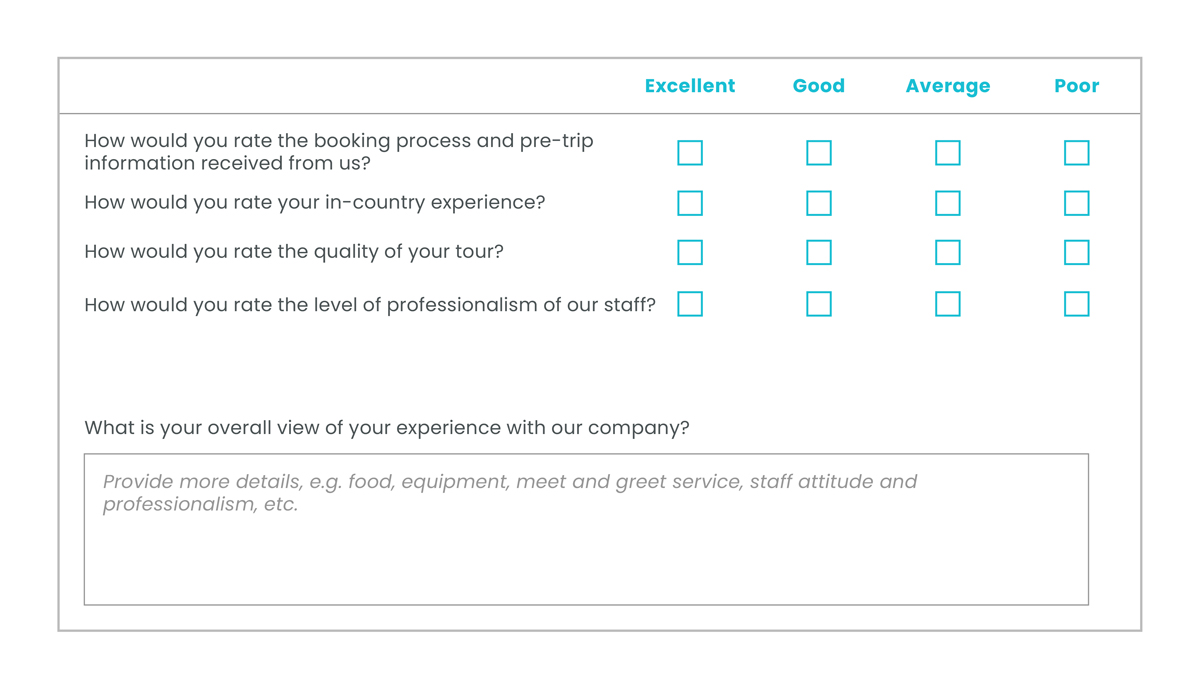
You will be surprised how much detail customers give, if they are asked to write down their feedback.
After reviewing responses from the online survey, it will be clear which reviews are great, average and bad.
The task is to follow up with a public review request with the great ones and take action, where necessary, to make things right for the customers who left bad reviews.
Public feedback
Now that you have filtered for the best reviews, you need to get customers to post publicly on your main review network.
To make this process easy for customers, we recommend sending them an email to thank them for their great online survey feedback.
Explain in the email how important reviews are for your company and request that they visit your main review network to leave a public review.
To make their lives easy, we recommend including in the email a copy of the assessment they left on the online survey. Suggest that they can simply copy and paste their review.
Here is an example email you can use.
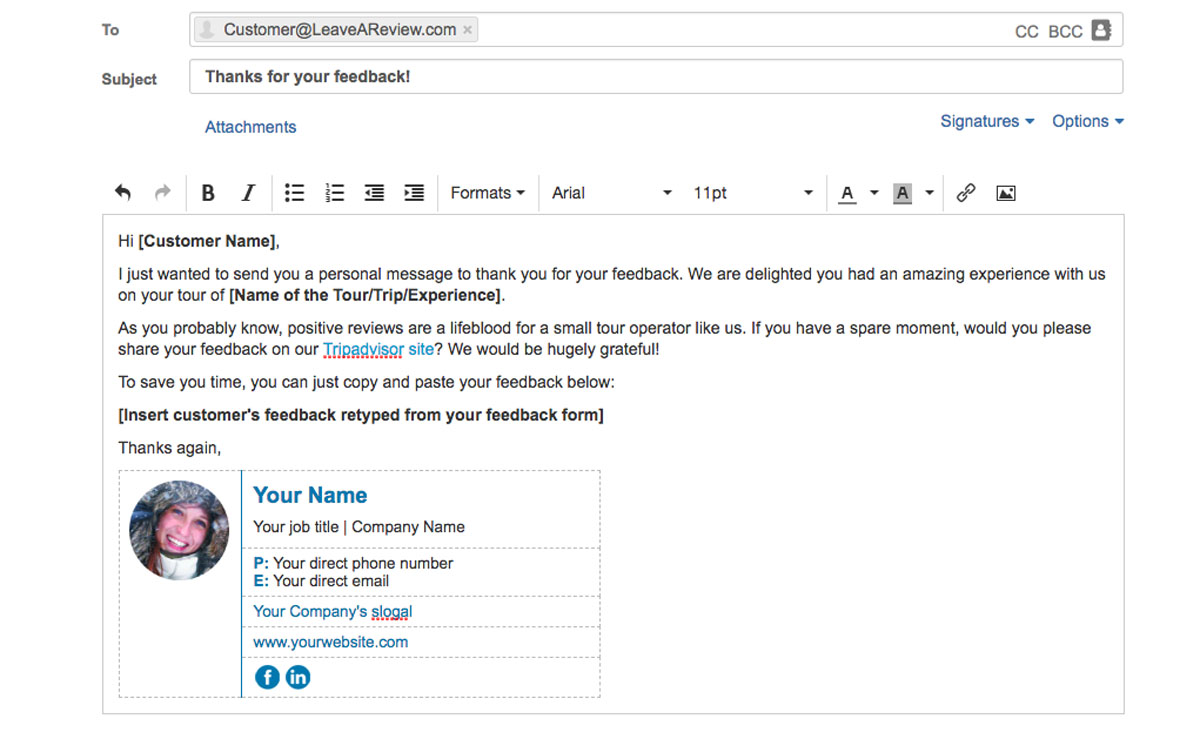
Follow this process and in no time you will have 100s, if not 1000s of excellent reviews. Just like Trailfinders below.
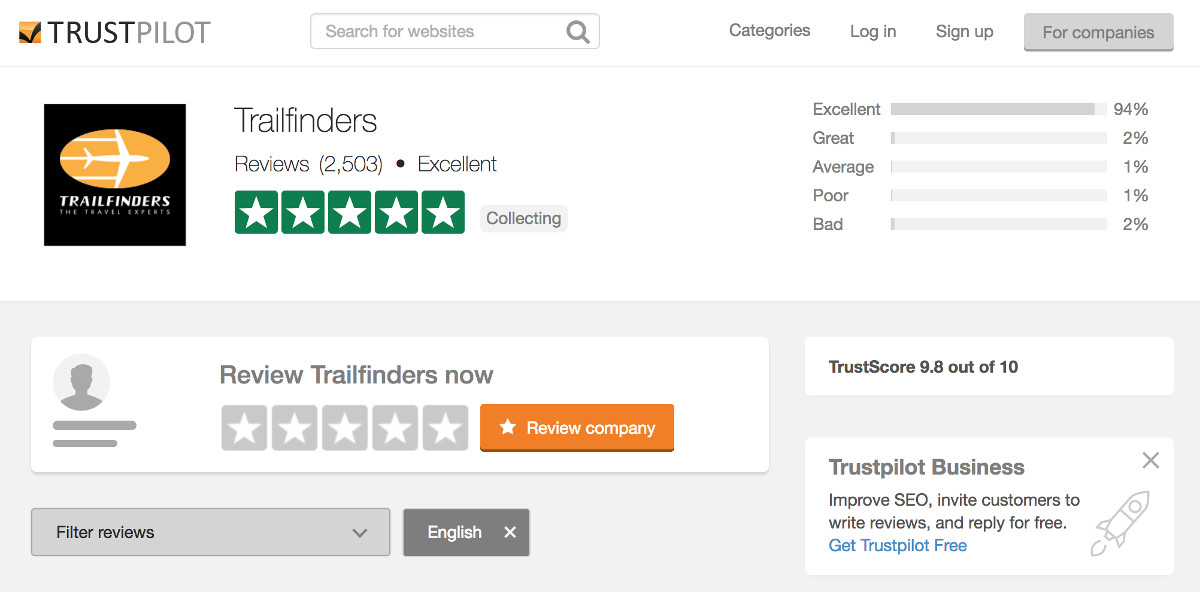
Broaden Review Presence
As your core review profile starts to mature it is worth thinking about expanding your review presence across multiple platforms.
There is no hard and fast rule on when to start broadening your review profile, but generally, once you have 50-100 reviews on a core review network, then spreading some reviews onto other 3rd party sites makes sense.
The way to do this is by building in a multiple review request with a select few customers who are true fans of your service.
Instead of sending them the email we discussed above requesting to place their review on your main review profile, ask if they can also share it on one or two more platforms. Explain how much this would help your company.
Other review platforms we recommend using are:
Google Business Listing
As we discussed in our article on Distribution Channels, getting a Google Business listing is a good idea regardless of the potential of Google reviews.
Here’s how to setup a Google Business listing for your tour operation.
The way reviews work on Google Business is – once you get 5 customer reviews, they will display on search results for your brand.
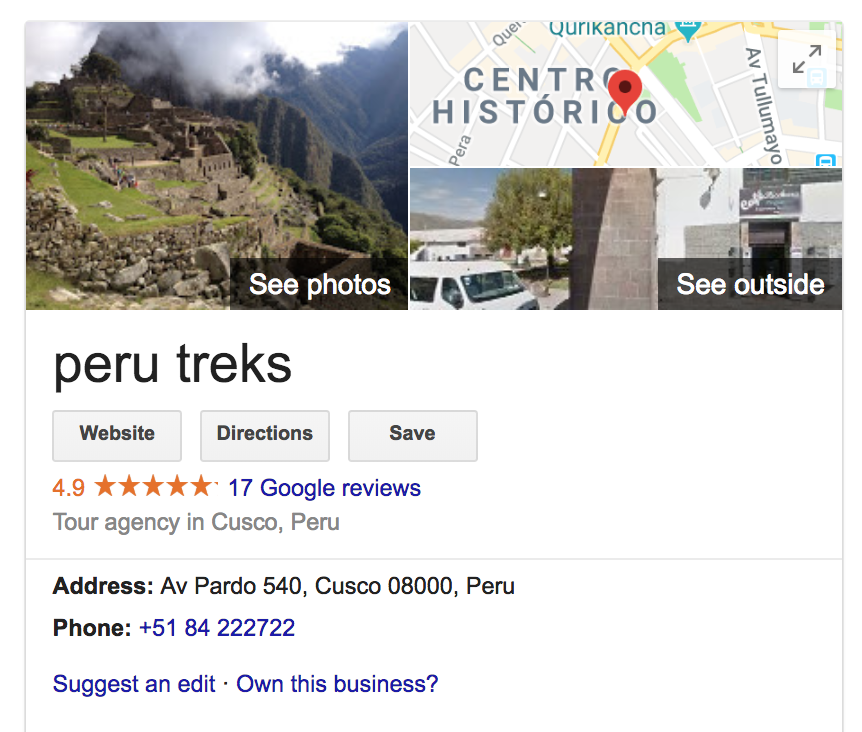
Facebook Business Page
Every Facebook Business page comes with a review module that you can easily activate and collect reviews on.
Here’s how to setup Facebook reviews.
Facebook reviews are great as not only do they display prominently on your Facebook page, but they will also usually appear when a prospective customer searches for your brand online.

Travel Marketplaces
In addition to being great distribution channels to reach prospective customers, online travel marketplaces (OTAs) like Viator, TourRadar and Expedia, are also great platforms for collecting reviews.
If you promote your tours via OTAs it is definitely worth collecting as many reviews on these platforms as possible.
A strong OTA review profile will not only mean higher ranking of your tours within the platform, but also provide exposure in the search results where your OTA listing appears.
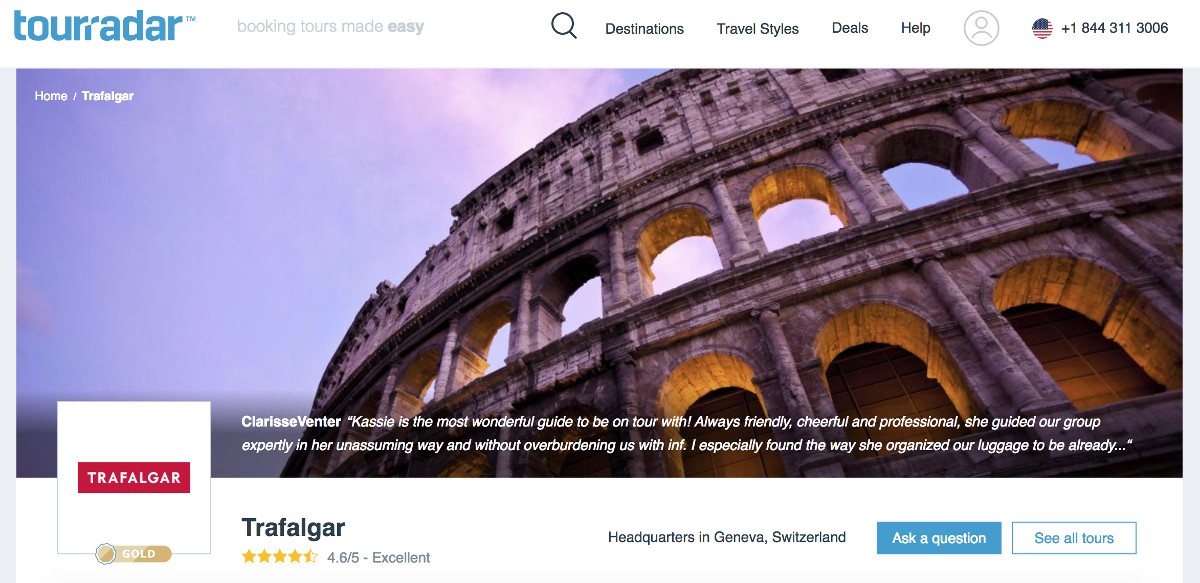
Niche Marketplaces
If your tour offering is very niche, then it is worthwhile exploring the web to see if any niche-specific marketplaces exist. For example, Safari Reviews for safari operators or Retreat Center Directory for yoga retreats.

Bad Reviews
Bad reviews happen. They are inevitable so there is no point trying to hide from them. Instead, we recommend embracing bad reviews.
Use the opportunity of a bad review to respond with as much empathy and transparency as possible.
Here are four areas to focus on for your response:
- Open with a personal thank you and apology: This lets the reviewer know that you value their feedback and are genuinely sorry they had a bad experience.
- Acknowledge and address: Take the time to acknowledge their complaint and then address each point in turn. If you feel the review is really unfair, clarify the points of disagreement but don’t be defensive.
- Make things right: Set out how you plan to make things right. Don’t set out the specifics in the review but mention that a manager will reach out to them directly to make things right. If you have already tried to make things right then spell out what you have done.
- Write with future customers in mind: Remember you are not only writing a response to the reviewer, but more importantly to future customers. The latter group will want to see how you respond to bad feedback. What corrective measures you put in place and how you listen and embrace feedback.
Always take the time to reread your response before posting. If it comes across as angry, defensive or rude, do not publish it. Remember, the response is much more relevant to future customers.
Under no circumstances should you leave a bad review unanswered. This will ultimately reflect badly on you.
Pro tip: If you feel a review is completely untrue or unduly malicious, make sure to gather as much written evidence (for example, customer emails that prove the customer is lying about their experience) and share this with the 3rd party platform in a request to have the review removed.
Summary
Online reviews are integral to the success of a travel operator. Without a good review profile many prospective customers will think twice before they book, if they book at all.
Growing a strong review profile requires a clear focus on a single review network to start with. Ideally, the core network you focus on should be well regarded as independent and trusted by customers.
A systemized process for collecting reviews that includes daily feedback, headquarter feedback and public feedback is the best way to scale good reviews and deal with complaints before they are posted publicly.
Broadening the base of reviews across multiple platforms should be a priority once a core review profile matures.
Did you enjoy this article? Get a FREE e-book: 150-page guide that covers everything from establishing a winning travel brand to delivering a market-leading service.
New resources, straight to your inbox
We’re committed to your privacy. WeTravel uses the information you provide to us to contact you about our relevant content, products, and services. You may unsubscribe at any time.

